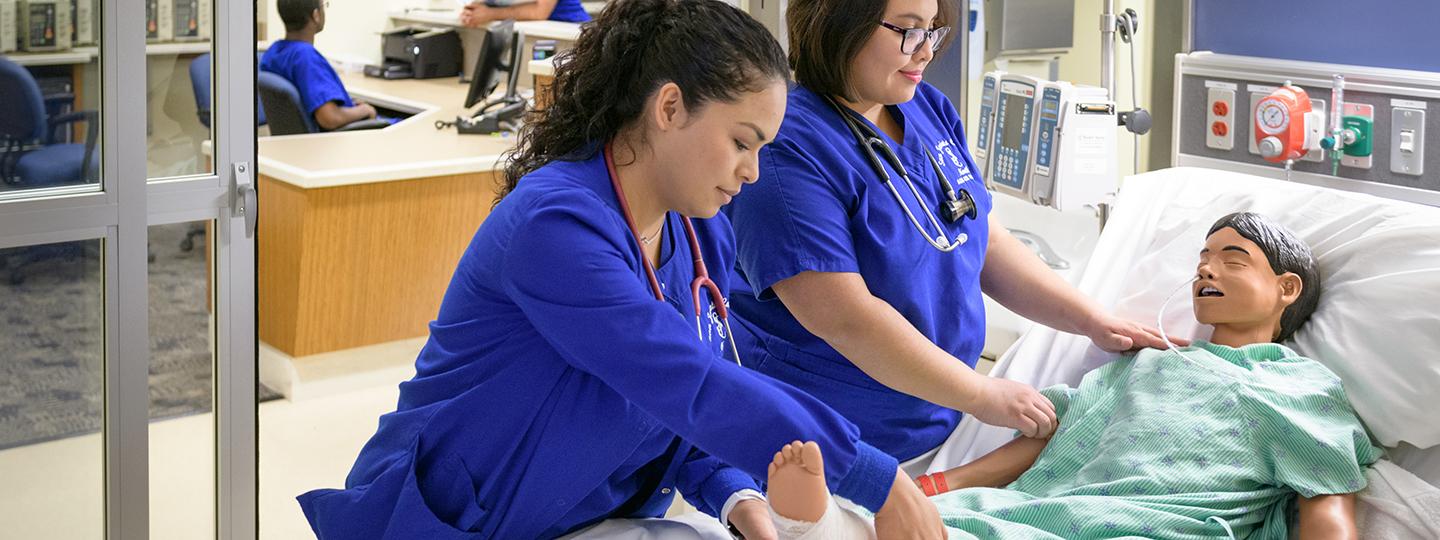No dummies: Simulators provide realistic patient care training

As the nursing students leaned toward the child patient simulator, one holding an
IV needle, they didn't expect what happened next: The manikin screamed.
San Jacinto College Central Campus simulation lab coordinator Karen Malloy laughs as she remembers remotely manipulating SimJunior — a four-foot-long manikin in a hospital bed — to mimic how a 6-year-old might behave.
"I made him say, 'No, no, no!' a lot," Malloy said.
Ranging from low- to high-fidelity models (levels of technological complexity), simulators like SimJunior provide consistent training opportunities to develop the critical thinking skills students need for health care careers.
"People might call them dummies, but they're not dumb. It's amazing what they can do," Malloy said.
History of sim labs
Medical training has come a long way. In her student days, Malloy learned to give shots by sticking an orange. Now students can inject a needle into a realistic arm with simulated blood circulation.
In fact, today's manikins are so complex that faculty and students usually just call them patients.
"Simulation lets students put into practice the skills they learn before they deal with an actual patient. It's a safe environment for learning without harming a real person," Malloy said.
San Jac began implementing dedicated simulation labs around 2009 at every campus to train students in multiple health science programs.
While many colleges have these labs, San Jac's are specially designed to resemble intensive care units with private patient rooms. This partitioning allows several groups of students to participate in different scenarios at the same time.
From a computer control room, faculty members can use programmed settings or independently manipulate the manikins to create unique training scenarios.
Simulation lab coordinators like Malloy, Becky Shuttlesworth at South Campus, and Daniel Covan at North Campus receive training from the simulator companies and at user conferences, then teach other faculty how to operate the manikins.
Complex patients
Each manikin contains a computer and connects to a bedside monitor displaying vital signs and to two control room computers.
While faculty members use prerecorded sounds like coughing and wheezing, they will often speak through the manikins to the students. For Pediatric Hal, a high-fidelity child manikin, the computer modulates the faculty member's pitch to sound like a 6-year-old's voice coming from Hal's mouth.
Scenarios generally happen in real time, with the exception of the maternity manikin, a supermom who can simulate labor and birth in a record 15 minutes.
Because of countless possible scenarios, nursing students aren't the only ones visiting the simulation lab. For example, eye care technology students have used manikins whose eyes dilate, and respiratory care students have worked with a newborn manikin that can turn blue and exhibit breathing problems, seizures, and other neonatal conditions.
Sim scenarios
Scenarios start as if students have just walked onto a hospital shift.
These "health care providers" receive a patient report, with vital information about the patient's medical record and care already administered that day.
"I tell the students, 'When you're in the room, you're the nurse, not a student.' We never put them in a scenario they're not prepared for in some way. The scenarios are kept at the same level as their training," Malloy said.
Scenarios involve about five students, including two nurses and a bedside companion to help with patient privacy training. Nurses must know this companion's relationship to the patient before sharing certain information aloud.
A sneaky faculty member might even call the nurse's station outside the room, pretending to be a mom and requesting medical information about her adult child.
After the 15- to 20-minute scenario, students participate in a debriefing session with faculty. Rather than approaching students with a critical mentality, instructors ask probing questions to help students learn from any mistakes.
"I like to ask, 'What was your thought process when you took this action?'" Malloy said.
The simulation lab is not about learning skills but about applying critical thinking. Students learn through self-evaluation and self-discovery.
"One of the most gratifying parts is when students say they used what they learned in sim lab later in a clinical rotation setting," Malloy said.
And when it comes to handling rambunctious 6-year-olds, SimJunior might just be the best preparation yet.
